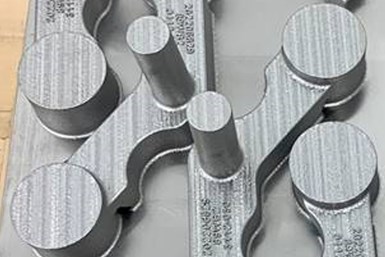USAF, GE Additive 3D Print Out-of-Production Metal Parts
The upcoming final phase of the Pacer Edge program is to establish the USAF’s own metal additive production infrastructure initially at Tinker Air Force Base in Oklahoma.
Share
Read Next

Metal 3D printed production parts for the Pacer Edge program (printed in cobalt-chrome and nickel alloy 718 on a GE Additive Concept Laser M2) nine months after requirement flow down. Photo: GE Additive
The U.S. Air Force (USAF) and GE Additive recently entered the third phase of its ‘Pacer Edge’ pathfinder program. Phase III has focused on 3D printing for four parts that are currently obsolete — a bell crank, gearbox seat, anti-icing valve body and a cross shaft arm. The first two parts (the cross shaft arm and the bell crank) have been successfully printed in cobalt-chrome on a fleet of M2 Series 5 system at GE Additive’s Cincinnati facility.
The final phase of the program over the coming years is to establish the USAF’s own metal additive production infrastructure initially at Tinker Air Force Base in Oklahoma. This capability will alleviate long lead timetables that currently plague the casting and forging industries.
“Pacer Edge represents a monumental step forward in innovative partnership with industry,” says John Sneden, director of propulsion, USAF. “Through this program, our enterprise team will deliver safe and timely propulsion readiness in support of the United States warfighter.”
It is said the USAF is not the only entity struggling to receive their castings and forgings in a timely manner. It remains a choke point for many industries and has only been exacerbated by the COVID-19 pandemic.
“Public-private initiatives like the recently announced ‘AM Forward’ initiative will also help to address DoD’s sustainment and readiness challenges head on,” said Lauren Tubesing, director of operations, Military Programs at GE Additive. “Strengthening U.S. supply chains, by encouraging small- and medium-sized manufacturers across the United States to adopt metal additive technology, will create a nationwide network of a qualified additive manufacturing suppliers.”
Related Content
-
What Is Neighborhood 91?
With its first building completely occupied, the N91 campus is on its way to becoming an end-to-end ecosystem for production additive manufacturing. Updates from the Pittsburgh initiative.
-
Variable Resistance Valve Trim Achieves Lead Time Reduction Through AM: The Cool Parts Show #69
Baker Hughes is realizing shorter lead times and simplified manufacturing through powder bed fusion to produce valve trims previously assembled from many machined metal parts.
-
The Cold Spray Solution to the Casting, Forging Supply Chains
Startup HAMR Industries performs additive manufacturing work at Neighborhood 91 that provides an alternative to traditional casting and forging. Success so far has led to redefining the limits of its additive equipment.














